VIJVER S
In de natuur, veel vissen bereiken nooit de volwassen grootte omdat ze worden opgegeten door andere dieren of roofdieren of sterven door ziekte of gebrek aan zuurstof. Viscultuur in vijvers probeert de situatie te beheersen om meer vis te produceren. In vijvers kunnen roofdieren worden bestreden, zodat de vijver meer vis oplevert dan de natuurlijke wateren. De groei van vissen in vijvers komt vooral doordat vissen niet kunnen ontsnappen, en voeden, fokken, het kweken en oogsten van de vis gebeurt op een goed geplande manier.
Viscultuur wordt beoefend in vijvers. Dit zijn kleine ondiepe wateren in natuurlijke omstandigheden en volledig afwaterbaar, meestal kunstmatig aangelegd. De natuurlijke vijvers verschillen van de meren doordat ze een relatief grote kustzone en een kleine diepe zone hebben. Hun waterbron kan ook variëren.
H ist O R ja
Het kweken van vissen in vijvers is een zeer oude praktijk. Vissen werden al in 2698 voor Christus gekweekt. in China. Viscultuur leek voor te komen wanneer de beschaving zich voor een lange periode vestigde. Viscultuur werd gedaan in het oude Egypte en in China, die al meer dan 4000 jaar een ononderbroken beschaving heeft. Het eerste schriftelijke verslag van de viscultuur in vijvers was van Fan Lai, een Chinese viskweker in 475 v. Chr. De oude Romeinen introduceerden karpers uit Azië naar Griekenland en Italië. Tegen de zeventiende eeuw, karpercultuur werd in heel Europa beoefend.
W H ja fi s H gr O met wie l N po N NS s
De praktijk van viscultuur in vijvers is voordeliger. Het is gemakkelijker om vissen uit een vijver te vangen dan om ze uit een natuurlijke hulpbron te halen. Visgroei kan worden gecontroleerd. Vissen kunnen extra voer krijgen om hun marktwaarde te verbeteren. Natuurlijke vijanden kunnen worden voorkomen dat ze de vissen in de vijvers doden. Vissen kunnen worden beschermd tegen ziekten. in vijvers, de productie van vis kan worden verhoogd met wetenschappelijk management en er kunnen meer inkomsten worden gegenereerd. Viskweek kan een boer helpen om het land zo goed mogelijk te gebruiken. Het uitwaaieren van vissen kan ook voor extra inkomsten zorgen.
t ja pe s O F fis H boerderij s
Er zijn twee belangrijke soorten viskwekerijen, voornamelijk gebaseerd op de aard van de kweek.
1. De viskwekerijen waar vissen worden gefokt om de jongen en de jonge kuikens groot te brengen.
2. De viskwekerijen waarin de jongen of de jonge pootvisjes worden opgekweekt tot verkoopbare maat. De boer moet beslissen wat voor soort viskwekerij hij gaat starten.
B een s e NS O N wat e R sup P ik ja t O pon NS s , t H e ja ar e cla s si F d.w.z NS l N t O 5 t ja pe s .
S prio N G wa te R P ond s :Bronwatervijvers worden gevoed door grondwater, hetzij door natuurlijke bronnen op hun bodem of door andere die ernaast liggen. Het bronwater is goed voor de viscultuur omdat het schoon is en er geen ongewenste vissen of viseieren in zitten. Als de bron een lange afstand heeft afgelegd voordat deze in de vijver is afgewaterd, het kan verontreinigingen bevatten en moet vóór gebruik worden gefilterd.
R een l N wa te R P O N NS s :Deze worden ook wel luchtvijvers genoemd. Deze zijn gevuld met regenwater en de mate van vulling is afhankelijk van de hoeveelheid regen.
W e ik ik met wie een te R pon NS s : Deze zijn gevuld met bronwater en worden als zeer goed beschouwd voor de viscultuur. Ze kunnen voldoende worden voorzien van water dat geen verontreinigingen bevat.
F ik O O NS meer een l N OS – B O met wie P Aan NS s :Water voor deze vijvers wordt geleverd door de beek. Deze zijn zeer productief vanwege de ophoping van organische materialen en periodieke overstromingen.
W Bij e R C ou R s e P Aan NS s : Deze vijvers zijn op de loop van stromend water geplaatst en verder onderverdeeld in twee hoofdtypen.
B een se NS O N met wie een t e R s jij ppl ja , s O l ik een N NS t O P ogra P H ja t H e P O nd s ar e O f vijf types.
Veel aspecten van de aanleg van deze vijvers zijn hetzelfde. Het belangrijkste verschil tussen deze is de waterbron. Dit zijn :
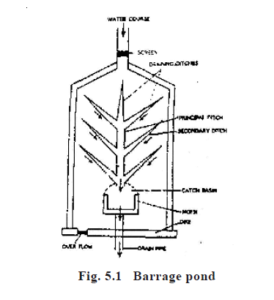
B een R ra G e P Aan NS s : Deze vijvers worden meestal gevuld door regen of bronwater. Een veer, bijvoorbeeld, stuurt water dat door een kleine vallei of een helling naar een lage plaats stroomt. Of, een bron borrelt uit de grond in een natuurlijke depressie. De vijver wordt gevormd door water op te vangen aan de voet van de vallei en op de lage plaatsen. De boer doet dit door een muur of dam te bouwen die het water binnenhoudt, wat nu, is het vijvergebied. Het aantal vijverwanden dat moet worden aangelegd, is afhankelijk van de grond en het drainagesysteem. Een stuwvijver heeft meestal maar één muur nodig:de hoofdmuur tussen de waterbron en het vijvergebied.
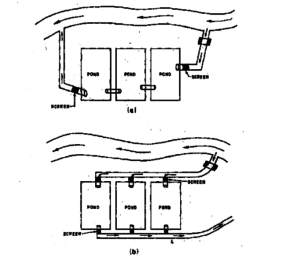
NS ivers l O N vijver s een ) Ro s ar ja systeem m B ) P aralle ik s ja ste m
Een soort drainagesysteem, een sluiskar genaamd, kan worden gebruikt om water zowel in als uit de vijver te laten. Er zijn ook een aantal eenvoudige drainagesystemen die kunnen worden gebruikt die geen ingewikkelde constructie vereisen.
Spervijvers (Fig. 5.1) mogen niet worden gebouwd waar de waterstroom te groot is, omdat het moeilijk is om te voorkomen dat het water door de muur breekt als de waterdruk te groot is. Beken en stromen die goed stromen, maar niet te sterk goede bronnen zijn voor stuwvijvers.
Zelfs als de waterstroom niet groot is, echter, stuwvijvers hebben overloopkanalen nodig. Omdat stuwvijvers meestal in lage gebieden worden gebouwd, ze zullen waarschijnlijk worden opgevuld tijdens zware regenval. Overloopkanalen vormen elk soort systeem dat kan worden opgezet om te voorkomen dat de vijver te veel water verzamelt. De overloop haalt extra water uit de vijver. Als dit extra water niet wordt afgevoerd, de vijvermuur kan breken.
NS ik heb R sio N pon NS s :
Deze vijvers worden gemaakt door water uit een andere bron, zoals een beek of rivier, om te leiden. Er worden kanalen gegraven om het water van de waterbron naar de vijver te voeren. Omleidingsvijvers kunnen op verschillende manieren worden gemaakt. Soms wordt een vijver in vlakke grond gegraven of kan worden gemaakt door een natuurlijke inzinking in het land iets te vergroten. Deze vijvers hebben muren nodig, afhankelijk van de topografie van het land, het drainagesysteem, enzovoort.
In omleidingsvijvers (Fig. 6.2), het water wordt altijd via omleidingskanalen naar de vijver gebracht in plaats van direct de vijver in te lopen. Water kan op verschillende manieren worden omgeleid. Een kleine beek die zijn water uit een grotere beek in de buurt haalt, kan worden afgedamd en gebruikt als afleidingskanaal om een vijver te voeden. Omleidingsvijvers kunnen op twee manieren worden aangelegd.
R osar ja sy s te m :
Deze vijvers worden achter elkaar in een touwtje gebouwd. Alle vijvers lopen in elkaar over en moeten worden beheerd alsof het één vijver is. Als de eerste vijver in de serie met een waterinlaat vol zit met roofdieren die vergiftigd moeten worden, alle andere vijvers moeten worden geoogst en leeggemaakt voordat de eerste vijver kan worden vergiftigd.
P aralle ik systeem :
Elke vijver heeft zijn eigen in- en uitlaat. Daarom, elke vijver kan als een aparte vijver worden beheerd. Het parallelle systeem is een beter systeem. Maar rozenkranssystemen zijn goedkoper en gemakkelijker te bouwen. Als de waterbron goed is, en kan vrij worden gehouden van roofdieren, en als het beheer van de vijver goed wordt gedaan, dit is een goedkoper en beter systeem.
Omleidingsvijvers zijn altijd beter dan de stuwvijvers. Dit komt doordat ze minder snel overlopen en de waterbron het hele jaar door betrouwbaarder is. stuwvijvers, echter, hebben minder constructie nodig en zijn waarschijnlijk goedkoper.
P ond s m een ja al s O B e C las s ifie NS een C C ordinaat G t O e ei R s iz e een NS jij doorzakken e in een vis boerderij naar binnen vijf types
Deze zijn geconstrueerd in overeenstemming met de eisen van de vis of zijn levensfasen. Dit zijn:
H ea NS po N NS :Deze vijver wordt meestal aangelegd in de buurt van een meerjarige waterbron. Het belangrijkste doel van de vijver is om te voldoen aan de waterbehoefte van de hele boerderij, rekening houdend met de verliezen door kwel, verdamping enz.
H Bij C Hoi N G P Aan NS s :Deze worden ook wel paaivijvers genoemd. Deze zijn klein en meestal in de vorm van kleine tanks of plastic zwembaden, gemaakt in de buurt van de spawn-verzamelcentra. In deze vijvers worden Hapas's gefixeerd. De eieren worden verzameld en in de hapas bewaard om uit te komen. Soortgelijke vijvers zijn ook aangelegd in de viskwekerij. Deze zijn iets dieper met watercirculatie. Hier ook, de hapa's zijn in de vijvers bevestigd. De broedmachines worden vrijgelaten in de hapa nadat ze hormonale injecties hebben gegeven. Het paaien vindt plaats in de hapa en de eieren mogen hier ook uitkomen.
N urs e R ja P ond s :Deze worden ook wel transplantatievijvers genoemd. Dit zijn seizoensvijvers en worden aangelegd in de buurt van de paai- en kweekvijvers. Het belangrijkste doel is het creëren van een geschikte conditie voor voedselbeschikbaarheid en groei van jongen, omdat ze in dit stadium het meest vatbaar zijn voor gevaren zoals golfslag en roofdieren. Dit moeten kleine en ondiepe vijvers zijn van 0,02-0,06 ha. in grootte en 1-1,5 m. diepgaand. In de kinderdagverblijven, het broed (5-6 mm) wordt ongeveer 15 dagen gekweekt tot het bakstadium (25-30 mm). Deze vijvers zijn meestal rechthoekig van formaat. Extra zorg moet worden besteed aan het opvoeden van de jonge stadia, anders kan zware sterfte optreden. Soms wordt het broed ook 30 dagen gekweekt. De vijverbodem moet licht aflopen in de richting van de uitlaat om gemakkelijk met netten te kunnen werken. Kleine en seizoensgebonden kwekerijen hebben de voorkeur omdat ze helpen bij een effectieve controle van de omgevingsomstandigheden. In de praktijk wordt ongeveer 10 miljoen paai per hectare opgeslagen in kweekvijvers.
R oor l N G po N NS s :Deze moeten iets groter zijn, maar niet proportioneel diep. Deze moeten zich in de buurt van de kweekvijver bevinden en hun aantal kan variëren afhankelijk van de cultuur. Ze zijn bij voorkeur 0,08-0,10 ha groot en 1,5-2,0 m diep. De jongen (25-30 mm) worden hier ongeveer 3-4 maanden gekweekt tot het vingerlingstadium (100-150 mm). De jongen die in kweekvijvers worden gekweekt, zijn relatief klein van formaat en niet geschikt genoeg voor hun directe overbrenging naar de uitzetvijvers. In visvijvers zijn waarschijnlijk grotere vissen aanwezig die op de jongen kunnen jagen. Vandaar, het is wenselijk om de jongen in kweekvijvers te laten groeien onder de juiste beheerpraktijken tot de grootte van de jonge vissen, zodat hun vermogen om predatie te weerstaan, zal worden verbeterd.
S tot ckin G vijvers :Dit zijn de grootste vijvers en zijn dieper, met een diepte van ongeveer 2-2,5 m. De grootte van de vijver kan variëren van 0,2-2,0 ha., maar deze moeten bij voorkeur 0,4-0,5 ha groot zijn. Deze zijn rechthoekig van vorm. De fingerlings en de advance fingerlings worden gedurende ongeveer 6 maanden tot verkoopbare grootte grootgebracht. Eenjarige vissen kunnen tot 1 kg groeien. of meer in gewicht.
verpleegkundige ja po N NS :
Het beheer van kweekvijvers is een van de belangrijkste aspecten voor succesvolle viskweekpraktijken. De jongen of spawn worden grootgebracht om stadia te bakken in kleine vijvers die kweekvijvers worden genoemd. de jongen, spawnen en jongen zijn uiterst delicaat, deze moeten, daarom, met de grootste zorg worden grootgebracht om een zeer goede overlevingskans te krijgen.
Kwekerijbeheer moet vanaf de zomer worden gestart, zodat het opkweken van een goede frituur mogelijk is. Opdrogen van kweekvijvers in de zomer helpt mineralisatie, verwijdering van organisch afval en vernietiging van roofdieren en wateronkruiden, die meer in meerjarige kwekerijen staan. De vijvers moeten worden ontzand, maar de fijne lagen van de ontzilt aarde die een rijke humusmatrix bevatten, zouden kunnen worden gebruikt om de zijkanten of geërodeerde bundhs in de kweekvijvers op te vullen. Dit helpt bij de mestwaarde van de rijke oppervlakkige laag aarde en draagt bij aan de productiviteit van de vijver. de verkooppunten, Inhammen en versterking van bunds moeten ook in de zomer worden aangepakt. De vegetatie op de bunds is een uitstekende broedplaats voor insecten, Vandaar, deze moeten worden vernietigd en de vegetatie moet in de zomer worden verbrand.
Als het drogen van de vijvers niet mogelijk is, het is beter om naar binnen te gaan voor vergiftiging van de vijver. Vergiften zoals endrin, tafadrine, derriswortelpoeder en Mohua-oliecake worden gebruikt om visvijanden uit te roeien. Voor een succesvol beheer van kweekvijvers moeten de volgende beheerstechnieken voor en na het uitzetten worden gevolgd.
Pre – sto C familie G pon NS m ana G eme N t
Het gaat om locatieselectie, uitroeien van onkruid, insecten en roofdieren, kalk, bemesting, enzovoort.
G met betrekking tot e N ma N ur l N G l N e e P Aan NS :
De groei van planten in een vijverbed is een noodzaak om de bodem te verrijken. Dit proces staat bekend als groenbemesting. De korte termijn gewassen van de vlinderbloemige familieleden zoals erwten, bonen, enz. helpen bij het verrijken van de bodem met stikstof. Na de groei van de planten, de vijverbodem wordt geploegd en geëgaliseerd met de wortels van de planten in de bodem. De knobbeltjes van deze plantenwortels verrijken de bodem met stikstof en zijn gunstig voor het verhogen van de vijverproductiviteit, wat resulteert in een hoge overlevingskans en snelle groei van jongen.
eh een dica t io N O F aq jij ati C gras s een NS pre NS atoren :
Wateronkruiden zorgen voor bepaalde problemen in de vijvers, zoals broedplaatsen voor waterinsecten, het mogelijk maken om roofzuchtige insecten te herbergen, beperking van het vrije verkeer van jongen, het veroorzaken van obstructie tijdens het netten en resulteren in uitputting van de planktonproductie. Vandaar, het onkruid moet in de zomer mechanisch of met chemicaliën worden verwijderd.
Roofdieren verwonden het broed en zijn verantwoordelijk voor een hoog sterftecijfer. Vandaar, de roofdieren moeten worden uitgeroeid uit de kweekvijver. De roofvissen zijn Channa sp., Wallago attu, heteropneustes fossielen, Clarias batrachus, Anabas testudineus, enz. die maximale schade aan het paaien veroorzaken, en gebruik ze als voedsel. Wietvissen zoals Salmostoma sp., Amblypharyngodon mol, Barbus sp., Esomus danricus, enz. zijn kleine en onrendabele vissen, die op karper paaien. Ze broeden in de vijver en concurreren met karpergebroed in de ruimte en voedsel.
Het volledig leegpompen van de vijver is de beste en eenvoudigste methode om ongewenste vissen uit te roeien. De sleepnetten moeten herhaaldelijk worden gebruikt om te vissen. Echter, aangezien de meeste roofvissen bodembewoners zijn, netten lossen het probleem mogelijk niet op. Daarom, de giftige stoffen voor vissen worden gebruikt om ze volledig uit te roeien. Endrin bij 0,01 ppm, dieldrin bij 0,01 ppm, aldrin 0,2 ppm en nuvan bij 30 ppm zijn nuttig om de voedervissen en alle andere visvijanden uit te roeien. Deze vergiften zijn 1-2 maanden effectief en het is niet aan te raden om ze herhaaldelijk te gebruiken. De gifstoffen hopen zich op in de vijverbodem en zijn daarna niet meer te verwijderen. Deze moeten ongeveer 60 dagen voor het uitzetten worden behandeld.
Derriswortelpoeder (4 ppm) is goed voor het uitroeien van foeragevissen uit kweekvijvers en is een week werkzaam. Mahua olie cake (Madhuca latifolia) bij 250 ppm is dodelijk voor foerageervissen. Het moet veertien dagen voor het uitzetten worden aangebracht. Na het dodelijke effect op voedervissen, het is later bruikbaar als mest. Suikerrietsuiker met een concentratie van 1% is ook dodelijk voor de vissen en het actieve gif is saponine. Theezaadcake is dodelijk voor viszaad met een snelheid van 600 kg/ha. Aanbrengen van 3-5 ppm poedervormige zaadkorrel van Croton tiglium, 2-6 ppm wortelpoeder van Milletia pachycarpa , 20 ppm zaadpoeder van Barringtonia accutangula , 12 ppm onrijp poeder Randia dumetorum en 10 ppm bastpoeder van Walsula piscidia is ook effectief.
kalken :
Kalkbekalking is het meest essentieel om de pH van water te behouden. Het water moet licht alkalisch zijn, omdat het nuttig is voor de uitroeiing van micro-organismen in de vijver en ook om de hygiënische toestand van het water te helpen behouden. Kalk is nuttig om de zure toestand die tijdens het bemesten ontstaat te neutraliseren. Kalk wordt toegepast met een snelheid van 250 kg/ha. In zeer zure bodems moet de dosis worden verhoogd tot 1000 kg/ha.
W Bij eric N G :
Tijdens het besproeien van de vijver, ervoor moet worden gezorgd dat er geen foerageervissen in de vijver komen, ook niet bij het ei, jong of volwassen stadium. Voor deze, water moet door een fijne zeef naar binnen worden gelaten. De kweekvijver moet tot een meter diepte met water worden gevuld.
ma N ur l ng :
Bemesten moet gebeuren na het vullen van de vijver met water. Het hoofddoel van bemesting is de productie van voldoende hoeveelheden plankton, wat nuttig is als natuurlijke voeding van karperzaad. Er zijn verschillende soorten mest beschikbaar om de productiviteit van de vijver te verhogen. De meest voorkomende , de beste en goedkoopste van alle mest is rauwe rundermest (RCD). Rauwe rundermest met een snelheid van 10, 000 kg/ha produceert een goede bloei van zoöplankton in 10 dagen. De toepassing van 5, 000 kg/ha pluimveemest produceert ook een goede hoeveelheid plankton in de vijver. Echter, het is beter om een geschikte mest te vinden die binnen 3-4 dagen plankton produceert. Een mengsel van 5, 000 kg/ha rauwe rundermest, 250 kg/ha enkelvoudig superfosfaat en 250 kg/ha arachideolie (GNO) bleken in ongeveer 3 dagen plankton op te leveren. Dit mengsel is geweekt in water, grondig gemengd en verspreid over het wateroppervlak, zodat de mest goed vermengd wordt met water, waardoor het tempo van de planktonproductiviteit wordt verhoogd. Het moet aanvankelijk ongeveer 10 dagen eerder worden aangebracht op de opslag en de resterende zeven dagen na de opslag. Als er twee of meer gewassen moeten worden geproduceerd uit dezelfde kweekvijver, dan moet de vijver worden bemest met 2, 000 kg/ha rundermest per week voor elke volgende uitzetting.
Anorganische mest is nuttig om de bodem te bemesten in plaats van water. 10:1 elementaire verhouding van N:P is vereist voor de groei van fytoplankton. Anorganische meststoffen worden gewoonlijk toegepast in 10 gelijke maandelijkse termijnen met een snelheid van 100-150 kg/ha/jaar.
Tijdperk NS icati N G ins e ct s een N NS ot H e R H een rmfu ik biota :
Insecten worden meestal het grootste deel van het jaar in grote aantallen aangetroffen in vijvers, vooral tijdens en na regen. Deze insecten verwonden het broed en moeten dus worden uitgeroeid. Vandaar, de insecten moeten vóór het uitzetten worden uitgeroeid om een maximale overleving van het broed te garanderen. Notonecta, Ranatra, Cyberster, Lethoceros, Nepa, Hydrometra en Belostoma zijn zeer destructief voor het karperzaad. De insecten kunnen worden uitgeroeid door olie-emulsies te gebruiken. Na het bemesten van de kwekerijen, ze moeten worden behandeld met een olie-emulsie.
Het sproeien van olie-emulsie is 12-24 uur voordat het broed in de kweekvijver wordt opgeslagen om de insecten uit te roeien. De olie-emulsie met 60 kg olie en 20 kg zeep is voldoende om een hectare water te behandelen. De zeep wordt eerst opgelost in water en wordt toegevoegd aan de olie en grondig geroerd om een bruingrijze oplossing te krijgen. Het wordt vervolgens verspreid over het wateroppervlak. Alle waterinsecten sterven door verstikking door de dunne oliefilm op het wateroppervlak. De spiracles van insecten worden gesloten door de olieachtige film zodat ze afsterven.
Een emulsie van 56 kg mosterdolie en 560 ml Teepol is ook nuttig om een hectare water te behandelen. Een emulsie kan ook worden bereid met dieselketelolie en een eventueel reinigingsmiddel. Omdat zeep erg duur is geworden, een effectieve methode is om 50 cc Hyoxyde-10 te gebruiken, gemengd in 5 liter water met 50 liter hogesnelheidsdieselolie voor een hectare water.
Het mengsel van Herter W.P (0,6-1,0 ppm) en olie gewonnen uit planten Calophyllum inofyllum is effectief voor zowel insecten als garnalen zoals paleamon lameni l, die meestal in kinderdagverblijven te vinden is. Een mengsel van 0,01 ppm gamma-isomeer van benzeenhexachloride en ethylalcohol is ook zeer giftig voor insecten. Toepassing van biologisch afbreekbare organofosfaten zoals Fumadol, Sumition, Baytex, Dipterex, enz. (0,25 tot 3 ppm) zijn nuttig om de insecten te doden.
Telkens wanneer een olie-emulsie wordt aangebracht, er mag geen wind zijn omdat het de oliefilm verstoort, en de doeltreffendheid ervan zal niet worden gevoeld bij de uitroeiing. Vogels als koningsvissers, reigers en aalscholvers zijn destructief voor frituren en vissen. Dunne lijnen die over de vijver worden gespannen, zijn de meest effectieve manier om ze te beheersen.
S t oke l ng :
Na te hebben voldaan aan de fysisch-chemische aard van het water en de aangroei van plankton in de kweekvijver, de spawn kan in de vijvers worden opgeslagen met een snelheid van 5-6 miljoen spawn/ha. Het uitzetten moet in de vroege ochtend of in de late avond worden gedaan, nadat het broed geleidelijk aan het vijverwater is geacclimatiseerd.
P oost- s tok l N G pon NS m anag e Heren t
Na het voorbereiden van de kweekvijver, het is beter om optimale fysisch-chemische eigenschappen en plankton te behouden. De bruine kleur van water onthult een rijke groei van zoöplankton. Groene of blauwe kleur onthult het overwicht van algen in het plankton. Vuile kleur onthult suspensie van slib in de waterkolom. Onderhoud van een meter waterdiepte is voldoende in kweekvijvers.
Onder de chemische eigenschappen, 3-8 ppm opgeloste zuurstof is goed voor de broedkuit. Kooldioxide boven 15-20 ppm is dodelijk voor vissen. Een pH tussen 7,5 en 8,5 is zeer productief. De totale alkaliteit van 100-125 ppm is zeer productief in water. 0,2 tot 0,4 ppm fosfaten zijn goed voor de productie van plankton en 0,06 tot 0,1 ppm nitraten worden voldoende geacht voor de groei van vissen. 1 ml plankton in 50 liter water in kweekvijvers wordt beschouwd als bevorderlijk voor het uitzetten van broed.
F eedi N G :
Na het inslaan, gedurende een of twee dagen zal het grootste deel van het plankton door het broed worden geconsumeerd. Overleving en groei van het broed worden beïnvloed door de kwaliteit en kwantiteit van het voedsel dat in de vijver beschikbaar is. Om een gezonde groei van het broed te verzekeren, kunstmatige voeding is noodzakelijk en wordt vanaf de volgende dag na het uitzetten hersteld. Het belangrijkste karpergebroed met een lengte van 5-6 mm weegt 0,0014 mg. De meest gebruikte kunstmatige voeders zijn arachideoliecake, rijst zemelen, kokosnoot, mosterd taarten, enz. Fijn gepoederde en gezeefde arachideoliecake en rijstzemelen gemengd in 1:1 worden gebruikt. Het voedingsschema is als volgt.
1-5 dagen na het uitzetten – het dubbele van het oorspronkelijke lichaamsgewicht van het broed. 6-10 dagen na het uitzetten – driemaal het oorspronkelijke lichaamsgewicht van het broed.
11-15 dagen na het uitzetten – drie tot vier keer het oorspronkelijke lichaamsgewicht van het broed.
Het niveau van kunstmatige voeding moet door de viskweker worden bepaald op basis van de studie van fysisch-chemische parameters en plankton.
H een rv e NS l ng :
In 15 dagen van kwekerij opfok, de spawn groeit tot 20-30 mm grootte jongen. In dit stadium, deze jongen konden worden overgebracht naar kweekvijvers. Bijvoederen dient een dag voor de oogst te worden gestaakt. De oogst moet in de vroege ochtend worden uitgevoerd. In dezelfde kweekvijver, 3-4 gewassen jongen kunnen in een seizoen worden grootgebracht.
R e arin G Pon NS Beheren m en t
Het beheer ervan is vergelijkbaar met het beheer van vijvers, behalve het materiaal en de bezettingsdichtheid. Dit kousmateriaal is bakstadium, die ongeveer 3 maanden wordt opgefokt tot het vingerlingstadium. De bezettingsdichtheid van jongen is 0,2-0,3 miljoen/ha.
S t ocki N G Po N NS ma N een edelsteen e N t
Na het opkweken van het viszaad tot aan de vingerlingen in kweekvijvers, deze fingerlings worden gefokt tot verkoopbare grootte in uitzetvijvers. De beheerstechnieken in kweekvijvers en uitzetvijvers zijn bijna gelijkaardig.
Om een maximale hoeveelheid vis te krijgen, moet uiterste zorg worden besteed aan de meest economische beheersmaatregelen. Het mag duidelijk zijn dat een groot deel van het succes van een visvijver afhangt van een zorgvuldige planning. De principes bij het rationeel beheer van de uitzetvijvers zijn het vergroten van het draagvermogen van de vijvers door bemesting en bijvoeding, optimale benutting van ecologische niches in de vijver door manipulatie van de bevoorrading, onderhoud van de waterkwaliteit, het kweken van snelgroeiende soorten en monitoring van de visgezondheid.
P re-s t oke l N G Mens een edelsteen e N t
Het omvat locatieselectie, conditionering van de vijvers, bewateren en bemesten van vijvers.
Cond l tio N in G t H e P ond :
Als de vijver een oude is waaruit de vissen zijn geoogst, het moet volledig worden geploegd. Ploegen helpt bij het drogen van de vijverbodem, verhoogt de mineralisatie, verwijdert de onaangename gassen die zich in de modder hebben opgehoopt en vernietigt wateronkruiden en ongewenste organismen. Ploegen van de vijverbodem verbetert de bodemgesteldheid, maar het mag niet zo diep zijn dat de vruchtbare toplaag wordt begraven en de steriele laag naar de oppervlakte komt. Het ontzilten van de vijver is essentieel om de productiviteit op peil te houden. De vijverbodem moet ontdaan zijn van takjes, takken en stronken of dode vissen. Daarna moet de bodem weer worden gladgestreken. Als de vijver voldoende is opgedroogd, de grond zal grote scheuren bevatten. Dat betekent dat het herstel van de vijverbodem nu het meest essentieel is om de fysieke, chemische en biologische toestand van de bodem.
tegen t ro ik O F een quati C wee NS s :
De groei van wateronkruid berooft de vijverbodem van voedingselementen, beperkt de beweging van vissen, interfereert met netten en herbergt roof- en onkruidvissen en insecten. Vandaar, het wateronkruid moet worden bestreden. De beste manier van onkruidbestrijding is het drogen en ploegen van de vijver.
Tijdperk NS ica t io N O F jij N desi R abl e O rgan l sms :
Het echte probleem ontstaat tijdens het kweken van vissen, wanneer de andere dieren de vis eten. Kikker, slangen en vogels eten jonge vissen en moeten uit vijvers worden gehouden. De ergste roofdieren zijn vleesetende vissen, die moeten worden voorkomen dat ze in vijvers terechtkomen door de waterinlaten af te schermen.
De gewone roof- en onkruidvissen (Fig. 5.3) in vijvers zijn: Channa sp. Clarius batrachus, heteropneustes fossielen, Wallago attu, Notopterus notopterus, Mystus sp., Ambassade ranga, Amblypharyngodon mol, Salmostoma sp., Esomus danricus, Puntius sp., enz. De wietvissen zijn kleine en oneconomisch vissen en worden meestal gevonden in vijvers. De ongewenste vissen komen per ongeluk in vijvers, door inkomend water samen met karperbroed. De roofvissen zijn schadelijk voor alle stadia van de spawn tot de volwassen stadia van karpers en jagen op deze karpers en concurreren met hen om voedsel en ruimte.
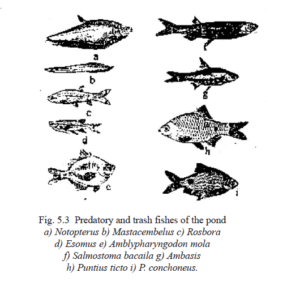
In welke vijver dan ook alle afvalvissen en roofdieren moeten worden verwijderd voordat de vijver wordt gevuld. De eenvoudige methoden om de vijvers te legen en te drogen en vervolgens om te ploegen, zijn het meest effectief om ze te beheersen. Als het aftappen niet mogelijk is, de vijver zo volledig mogelijk de ongewenste vissen moeten uit de vijvers worden verwijderd door herhaalde sleepnetten. Echter, veel vissen ontsnappen aan het net door aan de randen van de vijver te blijven. De bodembewoners houden van murrels, klimstokken, magur, singhi, enzovoort., die zich in de modder graven, zijn moeilijk met netten te vangen. Ontwateren is de beste methode, waarbij het water moet worden verwijderd door te pompen, hoewel dit een oneconomische methode is. In dit geval, de beste manier om van de ongewenste vissen af te komen, is door het water te vergiftigen in een vijver die niet kan worden leeggemaakt.
Er zijn verschillende soorten visgif op de markt verkrijgbaar. Deze zijn ingedeeld in 3 groepen - gechloreerde koolwaterstoffen, organofosfaten en plantaardige derivaten. Gechloreerde koolwaterstoffen zijn het meest giftig voor vissen. Deze worden opgehoopt in visweefsels en zijn stabiele verbindingen, die niet worden gemetaboliseerd. Organofosfaten zijn minder giftig voor vissen, maar ze hebben nadelige effecten op de waterflora en -fauna. De ophoping is minder in visweefsels en relatief minder persistent in water. Vandaar, de plantaardige bijproducten zijn goede visvergiften.
De beste natuurlijke vergiften zijn mahua-oliecake, rotenon van derriswortel, ongebluste kalk (160 kg/ha), theezaadcake (150 kg/ha), cameliazaadkoek (50 tot 200 kg/ha afhankelijk van de waterdiepte), tabaksafval (150-200 kg/ha) en katoenzaadpoeder (tabel 6.1). Een andere veilige chemische stof is saponine, dat is een verbinding van theezaadcake en wordt in een dosis van 0,5 ppm in de vijver aangebracht. De meeste natuurlijke vergiften worden afgebroken en verdwijnen binnen 7-12 dagen uit het water. mahua (Mahuca) latifolia) oliecake is een uitstekend gif, die na 10 dagen afbreekt en bruikbaar is als meststof. De chemicaliën zoals endrin, dialdrin en DDT moeten worden vermeden in vijvers, omdat ze jaren in de grond kunnen blijven en later alle vijvervissen kunnen doden.
Uitroeiing van waterinsecten (Fig. 5.4) wordt besproken in het beheer van kweekvijvers.
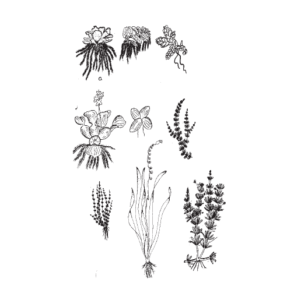
Afb. 5.4 Aquatisch insecten
kalken :
Kalk wordt vaak toegepast in aquacultuurpraktijken om de waterkwaliteit te verbeteren. Nadat de vijver is geploegd, opgeruimd en gladgestreken, het moet worden geconditioneerd met kalk. Bekalken verhoogt de productiviteit van een vijver en verbetert de sanitatie. Het is zowel profylactisch als theuraptisch. De belangrijkste toepassingen van kalk zijn;

Afb. 5.5 Aquatisch onkruid
a) Naturaliseer de zuurgraad van bodem en water.
b) Verhoog het carbonaat- en bicarbonaatgehalte in water.
c) Ga de giftige effecten van een teveel aan Mg tegen, K- en Na-ionen.
d) Doodt de bacteriën, visparasieten en hun ontwikkelingsstadia.
e) Bouw alkalische reserve op en stopt effectief pH-fluctuaties door zijn bufferende werking.
f) Neutraliseert Fe-verbindingen, die ongewenst zijn voor vijverbiota.
g) Verbeter de kwaliteit van de vijverbodem door mineralisatie te bevorderen.
h) Neerslag van overtollige opgeloste organische stof en dit vermindert de kans op zuurstofdepletie.
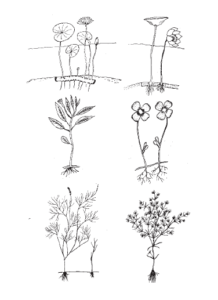
Afb. 5.6 Aquatisch onkruid
een) Nymphaea B) Nelumba C) Jussiaea NS) Marsilia e) Potamogeton F) Najas
i) Werkt als een algemeen vijverdesinfectiemiddel voor het onderhoud van de vijverhygiëne.
j) Aanwezigheid van Ca in kalk versnelt de samenstelling van organisch materiaal en maakt CO2 vrij uit bodemsediment.
k) Kalk maakt niet-beschikbaarheid van K voor algen.
Nieuwe vijvers kunnen worden gekalkt voordat ze met water worden gevuld. De kalksteen moet gelijkmatig over de droge vijverbodem worden verdeeld. In vijvers met water, het is beter om gelijkmatig over het wateroppervlak te verdelen. Of de vijver nu nieuw of oud is, op de bodem van de vijver dient een laag kalk te worden aangebracht. De kalk moet twee weken voordat het water in de vijver wordt gepompt aan de vijver worden toegevoegd. De beste tijd voor kalktoepassing is tijdens de periode dat de bemesting is gestopt. Tijdens het bemesten van de vijver mag geen kalk worden gestrooid.
De zeer zure bodems (pH 4-4,5) hebben een dosering van 1000 kg/ha kalk nodig, terwijl licht zure bodems (pH 5,5-6,5) ongeveer 500 kg/ha kalk nodig hebben. Bijna neutrale bodems (6,5 tot 7,5 pH) hebben slechts 200-250 kg/ha kalk nodig. De pH van de vijvergrond moet bijna neutraal worden gebracht voor maximale voordelen.
W Bij eric N G :
Nadat de kalk minimaal twee weken op de vijverbodem is aangebracht, het water moet langzaam worden binnengelaten. Het water moet uit de waterinlaat in de vijver vallen, zodat het water zich vermengt met zuurstof uit de lucht als het in de vijver valt. Het water mag niet te snel de vijver inlopen. Als het water te snel binnenkomt, de vijverbodem zal gaan roeren en zo het water troebel maken. Schermen moeten worden gebruikt bij inlaten, zodat de ongewenste vissen en andere organismen niet in de vijver komen. De vijver moet na het vullen enkele dagen vrij staan. De kwaliteit van het water in de vijver moet worden gecontroleerd voordat de vis erin wordt losgelaten.
ma N ur l ng :
Vissen hebben bepaalde elementen nodig om te groeien en zich voort te planten. Deze elementen zijn C, H2, O2, N2, K, P, S, Ca en Mg. Enkele andere elementen, sporenelementen genoemd zoals Cu, Zn, mn, ma, B, enzovoort., zijn slechts in kleine hoeveelheden nodig. Als deze elementen ontbreken of in zeer kleine hoeveelheden aanwezig zijn, de vis zal niet goed groeien. Vissen halen deze elementen uit de vijverbodem, het vijverwater en het voedsel dat ze eten. Sommige visvijvers missen elementen die nodig zijn voor de groei en productiviteit van vissen. In deze gevallen, het is noodzakelijk om meststoffen aan het water toe te voegen. De meststoffen zijn eenvoudige materialen die de ontbrekende elementen bevatten. De elementen die het vaakst ontbreken of schaars zijn in visvijvers zijn N2, P en K. Meststoffen die uit deze ontbrekende elementen bestaan, worden aan de visvijver toegevoegd om de groei van de vissen en van het plankton te bevorderen, die de vissen als voedsel gebruiken.
Een vijver die rijk is aan fytoplankton is vaak heldergroen van kleur. De kleur duidt op een bloei van algen. Bij een normale bloei de secchi schijf verdwijnt op ongeveer 30 cm diepte; wanneer de secchi-schijf verdwijnt op 20-40 cm diepte, de vijver is zeer productief en vruchtbaar. Onder deze omstandigheden is in een vijver geen bemesting nodig.
Soms kan een vijver te vruchtbaar worden. Als de secchi-schijf op slechts 15 cm verdwijnt, de bloei is te dik. De dikke laag groen blokkeert het zonlicht in de vijver en er kan geen zuurstof vrijkomen door het fytoplankton. In dit geval, er zit teveel mest in de vijver, en daarom moet een deel van de dikke laag algen die aan het wateroppervlak is gevormd, worden verwijderd. Deze vijvers hebben geen bemesting nodig.
Als de secchischijf op 43 cm diepte nog te zien is, het plankton in de vijver is niet voldoende. Het is, daarom, noodzakelijk om mest aan het vijverwater toe te voegen om een vruchtbare vijver voor te bereiden. Een andere factor die de behoefte aan meststoffen bepaalt, is de kwaliteit van de bodem. Als de grond zeer productief is, de behoefte aan meststoffen is minder; als de grond niet zo productief is, de behoefte aan meststoffen is groter.
De keuze van meststoffen kan worden bepaald op basis van de fysieke samenstelling van de bodem. In sandy or sandy loamy soils with low organic matter, fertilization is carried out with organic manures. In loamy soils with medium organic matter, a combination of both organic and inorganic fertilizer should be applied. In highly clay soil with rich organic matter, fertilization is carried out with only inorganic fertilizers. Amount of fertilizers to be applied to ponds may be worked out on the basis of the productive potentiality of the pond. The ponds can be categorised on the basis of N, P, organic carbon and alkalinity (Table 5.1).
In case of deficiency of potash, it can be included at the rate of 25-50 kg/ha/yr. The NP ratio should be 2:1. In aanvulling, cow dung may be applied at a rate of 10, 000-15, 000 kg/ha/yr. The best way to use this
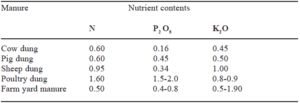
animal manure is to make a soup of it in a tank by mixing it with water. This soup should be spread in the pond. Fertilizer should be applied at a rate determined by the area of pond. Area is the length of the pond, multiplied by the width. Bijvoorbeeld, if a pond measures 20 m in length and 10 m in width, it has an area of 200 square metres (m2). This is equivalent to 2/100 of a hectare. To fertilize a 200 m2 fish pond with cow dung, at the rate of 1000 kg/ha, you must use only 20 kg.
Fertilization should be done 2 weeks prior to stocking the fish, so that, sufficient natural food is available in the pond. 1/5 of the total quantity of organic manure is required as an initial dose, and the rest is applied in 10 equal instalments. Organic and inorganic fertilizers may preferably be applied alternating with each other in fortnightly instalments. The amount of fertilizers required in general for fish ponds is 10, 000 kg/ha/yr of cow dung, 250 kg/ha/yr of urea, 150 kg/ha/yr of single superphosphate and 40 kg/ha/yr of murate potash. In large ponds, fertilizers may be applied by using boats.
NS O ckin G
Stocking is used to describe the act of placing the fish into the pond. The stocking density is used to describe the total number of fishes, which can be stocked in a pond. The stocking ponds are generally stocked with fingerlings which are about 75-100 mm in size. For increasing fish production, the selection of fish with desirable qualities is the most important biological factor. Since fish with the shortest food chain give the highest production, phytophagous, herbivores, omnivores and detritus feeders are preferred for culture in stocking ponds. For rearing of fish, either monoculture or polyculture in any species, combination may be carried out, most preferably the polyculture. The desirable stocking rate is 5, 000 fishes per hectare. In a monoculture pond, the stocking rate is the same as the stocking density because there is only one kind of fish. There is enough food and room in a pond for a particular number of fish. Good growth of fish depends upon the right number of fish cultured in the pond.
The stocking rate depends on the volume of the water and on the oxygen balance of the pond rather than the size of the pond. The ratio of fish to the volume of water should not be less than 1 fish to 2 m3 of water where there is no forced aeration.
As far as possible each pond should be stocked with silver carp and catla, the surface feeders. This should not be more than 30 to 35%, otherwise it would affect their growth adversely. Rohu is a column feeder and it should not be stocked more than 15-20%. Bottom feeders such as mrigal and common carp together can be stocked to the extent of 45%. Availability of aquatic weeds in the pond decides the stocking density of grass carp. It should preferably be about 5-10%.
Rearing of fingerlings to table-size fish may continue for one year or only 6 months. In the latter case, the stocking density may be reduced. In dit systeem, harvesting is done monthly and the number and species of harvested fish are replenished with a new stock of fingerlings. This is possible only where the supply of fingerlings is available throughout the year. Under these conditions the production is much higher than with the annual or 6 monthly stocking and harvesting.
In a polyculture of Chinese carp, the stocking density is about 20, 000 fingerlings per hectare. The stocking rates are 5, 000 grass carp, 5, 000 bighead carp and 10, 000 silver carp. If common carp is also included, then in a stocking density of 7 Chinese carps, 2 fish would be grass carp, 3 would be common carp, and there would be only one each of bighead and silver carp. In Maleisië, the ratio of carp stocking has been suggested at 2:1:1:3 for grass carp, bighead, silver carp and common carp.
If fishes are stocked in a pond, there should be enough oxygen, no temperature difference between the stocking water and the pond water. When the fingerlings are transported from a far away place, in order not to stress the fish, the bags with fingerlings are placed in the pond unopened until the water temperature inside the bags is about the same as the temperature in the pond. When it is same, the fingerlings are allowed to swim out of the container into the pond water by themselves. The fingerlings should not be poured into the pond water, as they die because of the shock of hitting the water.
Pos t -stock l N G beheren m en t
W een te R qua ik het ja Man een edelsteen e N t
Water quality managment is discussed in detailed
F e e NS Mana G eme N t
The feed management is discussed in detailed in chapter 6.
Heal t H Managemen t
The health managment is discussed in detailed in chapter 7
Harv e stin G
The fishes are harvested after a one year with the help of gill nets. Five to Six fisherman depending up on the size of the pond enter into the pond from one side, move to wards the other end with gill net and catch the fishes.
Aquatic onkruid en hun controle
Aquatic vegetation is described as aquatic weeds. Any undesirable vegetation which causes direct or indirect damage to the fishes or hamper the fishery operations may be described as weeds. In the tropical regions of the world, aquatic weeds grow luxuriantly causing nuisence to fisheries, water transportation and water supply systems, and provide conducive habitat for factors of several diseases. In India, ponds and tanks usually have fertile soil and water and so they invariably overgrow with all types of aquatic vegetation. For successful farm management, a strict watch on the growth of unwanted vegetation is necessary. With the presence of excess vegetation it becomes very difficult to net fishes in weed infested ponds.
Rea s Aan s NS R C op rol O F gras s
Uncontrolled vegetation growing excessively hinder fisheries interest in many ways. The weeds in the water reduce the yield of fish just as the weeds in the field reduce the yield of cultivated crop. It is necessary to control the weeds in fish ponds. Some of the reasons for this are quite obvious.
1. Due to the presence of aquatic weeds in the pond, the fishes cannot swim properly, thus restricting their ability to browse and hunt for food.
2. Weeds absorb nutrients for their growth and multiplication, thus absorbing nutrients essential for planktonic food of fishes which causes depletion offish food. Due to their presence, water loses its fertility to sustain fish stock.
3. Weeds offer shelter to unwanted predatory and weed fish, which hunt upon or compete with the cultivated varieties.
4. By profuse growth, weeds choke the entire water column, restrict netting and make navigation impossible.
5. The presence of weeds in water reduces the water holding capacity of the area and water loss due to evaporation through leaves occurs. In case of few weeds, the evaporation is much more than that from the open surface.
6. Weeds cause wide dirunal fluctuation in dissolved oxygen, temperature and other physico-chemical parameters to make the water inhospitable for fishes.
7. The weeds accelerate the process of siltation of the water area, ultimately turning it into a swamp.
8. Weeds harbour harmful insects, frogs, snakes and other predators enabling them to breed and multiply.
9. Weeds choke the gills of the tender young fishes.
10. The weeds interfere with the circulation and aeration of water, restrict the diffusion of sunlight and upset the normal chemical balance of the system.
11. The toxic gases in the pond bottom ooze produced by rotting organic matter cannot be easily eliminated into the atmosphere if the water surface is choked with weeds. In these conditions very few fish could survive in the water.
1 2 . Aquatic weeds are responsible for minimising water depth and ultimately cutting down the soil-water interaction which is so essential for recycling of nutrients for the fishes.
13. Thick algal blooms deplete the oxygen in the water during dark hours or when they die or rot and cause sudden mortality of the fish stock.
14. Some kinds of algae cause allergic irritations on human skin and make it difficult for people to get into the pond.
15. The fish yield is reduced in weedy infested water bodies. 16. Weeds affect water irrigational potential.
EEN dva N tage s O F met wie e ed s
Weeds do not always have harmful effects. The weed mass can be turned to some productive use which will recoup some of the losses involved in controlling them. The extra advantage of the utilization method lies in producing valuable end products. Different methods of control and utilization of weeds should be seen as useful tools in an integrated system of aquatic weed management. The aquatic weed are advantageous and help in the development and maintenance of a balanced aquatic community. The advantages are:
1. Aquatic weeds produce oxygen during photosynthesis and this oxygen is utilized by the fishes.
2. Weeds provide shelters for small fishes.
3. Weeds provide shade for fishes.
4. Weeds provide additional space for attachment as well as food for aquatic invertebrates which in turn serve as food for fishes.
5. Weeds help in the precipitation of colloidal clays and other suspended matters.
6. Weeds, after removal, can be used as bio-fertilizers and even used in fish farms.
7. Aquatic weeds are used as food for fishes like grass carp.
8. Weeds are also used for pollution abatement.
9. Weeds are used as a source of energy production.
W e e NS s een s NS O NS NS R F is H
There are a number of herbivorous fishes which directly consume aquatic weeds. The grass carp is a fast growing fish that feeds on aquatic weeds. The fish utilize submerged weeds like Hydrilla, Najas, Ceratophyllum, Ottelia, Nechamandra en Vallisnaria in that order of preference. The young fish prefer smaller floating plants like Wolffia. Lemna, Azolla en Spirodela. In composite fish culture the production is greatly enhanced by inclusion of grass carp because of its fast growth. It also occupies an ecological niche, which otherwise remains unfilled with the fear that the grass carp may breed and compete with the native fish population in natural waters, only the triploid grass carp which is supported to sterile is being allowed to be introduced.
The other herbivorous fish which utilize aquatic weeds are Pulchelluspulchellus, Oreochromis en Etroplus. Though an omnivore, Cyprinus carpio feeds well on filamentous algae like Pithophora en Cladophora. The manatee, Trichechus sp., a large air-breathing herbivore, is being utilized for the clearance of aquatic weeds in the canals of Guyana.
These advantages of water plants become negligible when they are present in excess and their control then, is essential. The methods to be adopted to control the aquatic vegetation can be formulated only after the plants are identified.
F een ct O R s C O ntr l bu t in G t O P rofuse G rowth
A number of factors either individually or jointly influence favourable growth of weeds in cultivable waters. These are :
1. Climatic condition and geographical situation of the area.
2. Water depth – lesser the depth, more is the growth of vegetation especially the submerged rooted or emergent vegetation.
3. Clarity of water or turbidity – more suspended material adds more turbidity thus retarding penetration of light in the pond which has an effect on the growth of vegetation.
4. Silt deposition at the bottom, promotes excessive growth of aquatic weeds.
5. Quality of water – fertile condition of water has its impact on the propagation of vegetation.
6. Infestation from other sources – the minute generative vegetative components like spores and cysts may be carried through the water supply, wind, overstroming, vogels, vee, enzovoort.
t ja pe s O F aq jij Bij l C wee NS s
The aquatic weeds (Fig. 5.5 and 5.6) are classified on the basis of habitat of plants – rooted weeds and floating weeds.
R O ot e NS met wie ee NS s
1. Bottom rooted weeds :Plants are rooted at the bottom of the water body and spread within the bottom layers of water. Vallisneria, Ottelia
2. Submerged rooted weeds :The plants are rooted in the bottom soil on the deeper margins of the pond and ramifying in the volume of water. e.g. Hydrilla, Chara, Potamogeton
3. Marginal rooted weeds :Plants are rooted on the marginal region of the surface layer of water and ramify on the surface of water and also on the adjoining land. e.g. Marsilia, Ipomoea, Jussiaea
4. Plants are marginally rooted and ramifying within the marginal region of the water volume. E.g. Typha, Scirpus, Cyperus, Panium
5. Emergent rooted weeds :Surface plants which are rooted in the bottom of the pond but their leaves float on the water surface or rise above the water level. They prefer shallow parts and shores of the pond. G. Nymphea (Lotus), Nymphoides, Nelumbium .
Flo een blik G gras s
1. Surface floating weeds :The plants are floating on the surface of water and with roots in the water. e.g. Eichhornia (water hyacinth), Pistia, Lemma, Azolla, Spirodele . Few surface plants, are floating on water but without roots g. Wolffia .
2. Submerged floating weeds :The plants are floating but submerged in the water e.g. Ceratophyllum, Utricularia .
3. We can also divide the aquatic weeds broadly as floating, emergent, submerged, marginal weeds and algal blooms and filamentous algae.
Meth O NS s O F wee NS co N t rol
Based on the intensity of infestation and type of weeds, the aquatic weeds can be controlled by means of manual, chemical and biological methods.
een . m een jij een ik een N NS mij C han l ca ik mij t hoezo NS
When infestation is scanty and scattered, the weeds can be controlled manually only in small water bodies. This is an ancient method and is still practiced in most of the places. The pre-monsoon period (April-May) is more suitable for manual removal. In many parts of the country, advantage is taken of the drought to control the weeds as ponds and other water bodies dry up or register a sharp fall in the water area, and the plants can thus be removed. Where labour is cheap, manual labour is often employed to remove aquatic weeds. The weeds are controlled manually by hand picking, uprooting the emergent and marginal weeds and cutting the others with scythes.
Most of the floating plants like Pistia, Lemna, Azolla, Wolfia en Eichhornia can be effectively controlled by clearing manually with nets, terwijl, the marginal weeds like grass, sedges, rushes, Typha , etc. may be controlled by repeated cutting. This method does not inflict any pollution and there remains no residual toxic effect as in the case of chemical treatment or shading. The weeds thus collected should be dumped far away, be converted into compost manure or burnt so as to have no chance of reinfestation.
Manual weed control is very expensive, time consuming and unsatisfactory. Daarom, mechanical devices have been developed. Cleaning of a weed infested water sheet through the mechanical method, becomes necessary where the water area is not shallow enough to walk through or small enough to uproot the weeds manually or cut them effectively with simple hand implements. Labour problem and an urgency of the work to eradicate the whole area of weeds within a stipulated time period before water level is raised, are the other factors which make it necessary to resort to mechanical methods for eradication of weeds.
A number of devices ranging from very simple barbed wire bottom rakers to sophisticated mechanical equipments like power winches with steel wire, under-water cutter, dredgers, mechanised removers, etc. are in vogue to use for the purpose. Broomfork, long fork, sickels or scythes, long knives, barbed wire netting, chaining and motor powered weed cutters are some of the specialised equipment used for this purpose.
Crusher boats are used to clear water bodies infested with water hyacinth. The rooted submerged weeds are dislodged mechanically by dragging with log weeders fitted with spikes and barbed wires. Mechanical winches are used for cutting and dragging of submerged weeds.
Another simple method of control of water hyacinth is to construct floating barriers which prevent water hyacinth from reaching other water bodies. The floating barriers reduce time, labour and cost as the accumulated weed is removed by draglines.
Laser rays are also used to control water hyacinth, usually of 10.6 nm wavelength. The irradiated plants are plasmolysed immediately.
Burning follows in proportion with the amount of laser energy applied. Many of the plants die within ten weeks. Daughter plants are stunted and turned pale due to destruction of chlorophyll.
C hemic een ik C O ntrol :
A large number of chemical weedicides are used for control of aquatic weeds. It is a very effective and cheap method. The weedicide is to be selected in such a way that it should be cheap and easily available, non-toxic to fish and man, should not pollute the water and should not involve the use of special and costly equipment. The lethal action of the weedicide is either by direct contact or by translocation of chemicals from the treated part of the plant to the other areas of its system resulting in both cases in the death of the plant.
Different type of chemicals are in use for eradication of weeds. Many of these are poisonous, toxic or harmful for human and other animals. Their mode of action on the weeds are also different. The same chemicals may not be useful for the eradication of different types of weeds.
Chemicals used for eradication of weeds are broadly classified under three categories.
1. Compounds of heavy metals. e.g. Copper sulphate, Sodium arsenate, enzovoort.
2. Hormone weedicides g.2, 4-D, 2, 4, 5-T, enzovoort.
3. Fertilizers. G. Superphosphate, Urea, Ammonia, enzovoort.
According to the mode of action, a weed killer chemical can also be grouped into two categories.
1. Contact weedicides – which kill plants on contact.
2. Translocated weedicides – which are absorbed by plants and are killed.
The contact weedicides may be selective or non-selective killer types. The selective killer type of chemicals are effective only on some specific weeds whereas the non-selective type chemicals kill all types of weeds. Besides weedicides, some chemicals are used as soil sterilants. It shows that all chemicals are not suitable for killing all types of weeds and all the chemicals may not have all the qualities required for commercial use. Some chemicals are extremely poisonous for animals and human beings. Some chemicals like fertilizers are required to be applied at a very high dose which is neither economical not easy to apply. Endothal, Endothal amine salt, 2, 4-D are toxic to fish. Diquot is toxic to fish and not advocated to apply in muddy water.
Biolo G ica ik tegenhouden t rol :
Of all the weed controlling measures, biological control of weeds through stocking the water with weed-eating fish, such as grass carp, Ctenopharyngodon idella, is found to be an effective and satisfactory method. Grass carp is a voracious weed eater and possesses strong pharyngeal teeth, which enables it to grasp and nibble at soft weeds like Hydrilla. The nature of its gill rakers helps it to sieve large quantity of microvegetation from the water body. Because of its efficiency for weed consumption and convertibility into flesh it is preferred for stocking in weed infested waters.
Grass carp usually eat the soft parts of the aquatic plants leaving behind the harder parts like stem. It shows a certain preference for soft submerged weeds like Hydrilla , Ceratophyllum , Najas , Vallisneria . Its lower preference towards Ipomea is due to the hard nature of the weed. Hydrilla verticellata is the most preferred as it has soft leaves which could be easily nibbled and are easily digested.
Control of weeds, especially the soft submerged type of weeds, through biological control by stocking the water with grass carp has certain advantages. It is not only the most economical due to its low cost of operation and easy application but also does not contaminate the water with toxic substances unlike chemicals used for control. Moreover, it gives economical returns by increased fish production.
gewone karper, Cyprinus carpio and Katti, Acrossocheilus hexagonalepsis and ducks are also used for biological control of aquatic weeds. Beatles and stemborers are also recommended for the purpose.
Biological control of weeds may be done by shading. Increasing turbidity, covering the surface by controllable floating weeds, shading the water area by canvas or coloured polythene sheets to cut down sunlight in order to check excessive growth and vegetation are some of the methods also in use.
Whichever method is used for the control of aquatic weeds, employment of manual labour is necessary. In the mechanical method labour is necessary for the clearance of the remains of the vegetative parts of the weeds. Even if the chemical method is resorted to, the dead weeds which sink to the bottom have to be removed. A rational utilization of all methods suitable according to the local condition and also economical is to be resorted to for eradication of weeds. Echter, checking of excessive weed growth at the proper time is also one of the effective and important factors to keep the weed under control. Control measures should be adopted before the flowering season of the weeds. The time for control of weeds given below has been found to be appropriate under Indian conditions.
January-February March-May
June-July July-August
August-September October-November
– Eichhornia, lotus – Duck weeds
– Utricularia, Ottelia – Jussiacea, Trapa,
N ymphoides , P istia , Nechamendra
– Najas, Myriophyllum – Scrispus, Nymphaea
W een te R Quali t ja m anageme N t
Successful pond culture operations mainly depend on maintenance of a healthy aquatic environment and production of sufficient fish food organisms in ponds. Water is the primary requisite to support aquatic life. Physical, chemical and biological factors play an important role in governing the production of fish food organisms and fish production in the pond. Water not only plays an important role in the fish production, but also it helps in the survival and growth of the fish. Vandaar, fish farmers should take a lot of care to maintain hygienic conditions in the pond, so that they get more profits. If the water quality is maintained with utmost care, the farmers need not spend much money for curing the diseases. If the water quality is maintained, the fishes also have a good taste. Water quality is influenced by physical, chemical and biological factors.
Physic een ik factor s
The physical condition of water is greatly influenced with depth, temperatuur, turbidity, light and water colour.
W een t e R afd H
Pond depth has a vital bearing on the water quality. Depth determines the temperature, the circulation pattern of water and the extent of photosynthetic activity. In ondiepe vijvers, sunlight penetration upto the pond bottom and facilitates an increase in the productivity. A depth of 1-2 metres is considered optimal for biological productivity of a pond. If the depth is very less, water gets overheated and thus has an adverse effect on the survival of the fish.
W een te R temp e ratur e
Temperature affects fish migration, reproduction and distribution. It depends on climate, sunlight and depth of the pond. Temperature varies vertically in the water body and also shows diurnal fluctuations. Fish posses well defined limits of temperature tolerance with the optimal being 20-32°C. Indian major carps can thrive well in the temperature range of 18-38°C. Wide fluctuations of water temperatures affect the survival of fish. In very low or very high temperatures, the fishes are strained, spend more energy and growth of the fish is affected. These temperatures also affect the chromatophores of prawns, and the prawns develop a red colour. If the temperature is maintained optimally, the red colour disappears. At low temperatures the food consumption offish and prawns decreases and gasses are produced at high temperatures. Vandaar, water temperature maintenance is very essential to obtain high yields. Fish and prawns or their seed have to be acclimatized whenever they are transferred from one pond to the other.
t jij rbi NS het ja
Water turbidity is mainly due to suspended inorganic substances like clay, slib, phyto – and zooplankton and sand grains. Ponds with a clay bottom are likely to have high turbidity. Turbidity reduces sunlight penetration and photosynthesis and hence acts as a limiting factor. If the turbidity is due to more suspended particles, they absorb nutrients in their ionic form, making them unavailable for plankton production. High turbidity also reduces the dissolved oxygen in the pond water. Turbidity is measured with the secchi disc. If the secchi disc disappears at 30-50 cm. the water is productive in nature. If it is not visible at a depth less than 25 cm, a dissolved oxygen problem could anse during the night. If it is more than 50 cm, the plankton produced is less in the pond water. In less turbid waters, the aquatic weeds growth is more. In highly turbid waters, the sand grains accumulate in the gills of the fish and prawns, causing suffocation and excessive secretion of mucous. High turbidity can be reduced by adding lime and alum. If the water is more turbid, it should be stored in sedimentation tanks and then used for fish culture. If the turbidity is more due to phytoplankton, water m the pond should be changed. Fertilizers have no effect in high turbid waters, hence fertilization of the pond should be stopped.
L l gh t
Availability of light energy to a fish pond greatly influences its productivity and photosynthesis. In ondiepe vijvers, light penetrates to the bottom and is responsible for luxuriant growth of aquatic weeds. In high turbid waters, the light will not penetrate to the bottom. Hierdoor, the vegetation at the bottom will decay and produce harmful gasses, which affect the fish and prawn life.
W Bij e R C O lou R
Water gets its colour due to phytoplankton, zoöplankton, sand particles, organic particles and metallic ions. Water used for fish or prawn culture should be clear, either colourless or light green or blue in colour. Water colour is golden or yellow brown if diatoms are more. This type of water is best for prawn culture. Brownish green, yellowish green and light green coloured waters are also good for prawn culture. Water becomes greenish in colour when phytoplankton is more, develops a brown colour due to zooplankton and mud colour due to more sand grains. Water with black, blackish green, dark brown, rood, yellow colours are not good for culture. These colours are due to the presence of more phytoplankton, bad pond bottom and acids in the water. The red colour of water is due to the presence of high levels of iron and death of phytoplankton (phytoerythrin released).
Chemica ik fac t of s
The chemical factors like pH, opgeloste zuurstof, alkaliteit, hardheid, phosphates and nitrates influence the productivity of the pond.
P H
pH is the hydrogen ion concentration, which ranges from 0-14. Water is slightly alkaline in condition, with the optimal range of 6.5-8. Less than 5 and more than 10 pH is lethal to fish and prawns. The pH of pond water undergoes a diurnal change, it is alkaline during the day time and slightly acidic just before day break. The fluctuations of pH are similar to dissolved oxygen. pH fluctuations are more in phytoplankton and weed infested waters and water with less hardness. No sudden pH fluctuations in brackish water and sea water occurs due to their buffering capacity.The difference in pH from morning to evening should not be more than 0.5. When pH increases, ammonia and nitrites become toxic, when it is reverse H, S becomes more toxic. pH below 6.5 and above 8.5 is responsible for reduction of growth and resistance of parasitic infection increases in acidic waters. Whenever pH falls, lime should be added to the pond water. When pH is high, lime should not be used. Urea should not be used to reduce pH. This is because NH3 becomes toxic at high pH. It is always better to add new water to maintain an optimal pH. Alum or aluminum sulphate can be used to reduce the pH and turbidity. Alum removes phenolphthalin alkalinity. 1 ppm alum reduces 1 ppm phenolphtahlin alkalinity. Vis, prawns and their seed should be acclimatized to new water whenever they are transferred from one pond to another.
Di s oplossen NS oxyge N
Dissolved oxygen is one of the most important chemical parameters, which has a great influence on the survival and growth of fishes and prawns. The pond water gets oxygen mainly through interaction of atmospheric air on the surface water of the pond and by photosynthesis. It is produced only during daytime, reaches a maximum at 3 PM, then gradually decreases upto early morning. During the night it decreases and it reaches a minimum during the early hours. It is due to nil production of dissolved oxygen at night and instead, consumption of oxygen by plankton, onkruid, fishes and prawns. During overcast days, the production of dissolved oxygen during the day is less and during the subsequent nights it decreases drastically. When water temperature rises, oxygen is released into atmosphere. When salinity increases it is dissolved in water. The optimum dissolved oxygen is 5-8 ppm. If less than 5 ppm the growth rate decreases the fish and prawns are prone to get diseases and less than Ippm of dissolved oxygen results in death. More than 15 ppm results in gas bubble disease in fishes and prawns. Whenever the animals are under stress due to less dissolved oxygen the food consumption temporarily decreases. When oxygen decreases, prawns accumulate on the water surface and near the pond shores and are found stationary at one place or show weak movements. Fishes come to the surface and engulf the air. Prawns get milky white spots when dissolved oxygen is continuously less. It decreases gradually from the surface to the pond bottom and CO, , NH3 and other gases increases, hence prawns are under more stress. Farmers should take precautionary measures at nights, especially during the early hours to increase oxygen levels. If it is very less, the water surface should be disturbed by beating water with bamboo poles or by rumming boats or by using aerators.
Alkalinit ja
Alkalinity is caused by carbonates and bicarbonates or hydroxides of Ca, Mg, Na, K, NH4 and Fe. Alkalinity is less in acidic soils and in ponds with more organic load. Alkalinity is more in clay soil ponds and is increased if water is pot exchanged. The optimal level of total alkalinity is 40-150 ppm. Alkalinity has direct effect on the production of plankton. ‘
H ar NS nee s s
Hardness is caused by Ca and Mg. Water with less than 40 ppm is soft and more than 40 ppm is hard water/ The pond water with a hardness of 15 ppm or more is satisfactory for growth of fishes and prawns and do not require additional lime. If water has less than 11 ppm hardness it requires liming for higher production. If it is less than 5 ppm, the growth rate is affected and causes eventual death of the fish.
S alin l t ja
Na, C12, Ca, Mg, K, bicarbonates and sulphates are responsible for salinity of the water. Salinity is an important parameter for survival, growth and high production in brackishwater culture systems. Salinity ranges between 0-40 ppt in brackishxvater and 35 ppt in sea water. The optimal salinity for prawn culture is 15-20 ppt. The prawns can survive at 2 ppt and 40 ppt. but their growth rate decreases. If the salinity is high, the water should be exchanged. Due to heavy rains more freshwater enters into the ponds and sudden decrease is found in salinity levels which affect the life in the pond. Om dit te voorkomen, two outlets (one at high level and other at low level) should be provided to send out freshwater and sea water separately from the pond. The animals should be acclimatised before introducing them into new water.
Ca R bo N dio x ID kaart e
CO, is produced during respiration and consumed during photosynthesis. CO, is less during daytime and more at nights. The optimal level of CO, is 5 ppm. At high CO, levels, pH decreases, CO, is accumulated in the blood of the animals and water becomes acidic. The animals become sluggish, loss of resistance occurs, they cannot utilize dissolved oxygen and they ultimately die. Whenever CO, increases lime should be added to the pond. 1 ppm of lime reduces 0.9 ppm of CO, .
Di s Sol v e NS amm O nee een een NS l t s C O mpo jij nd s
NH3 is found in excreta and is also released due to decomposition of organic matter. It is an important compound influencing the growth of phytoplankton in the aquatic ecosystem. The optimal limit of NH3 is 0.3-1.3 ppm and less than 0.1 ppm is unproductive. Whenever NH3 increases pH also increases, but dissolved oxygen decreases. CO2 reduces the toxic effect of NH3. NH3 also increases with feed due to high protein levels and death of phytoplankton. When NH3 is more in water, animals may not get excreta with NH3. NH, accumulates in the blood and oxygen transport in the blood reduces. – Gills become black, biochemical tissue is damaged and gasous exchange is affected. NH3 levels can be reduced with good management like no excess feed, optimal stocking and water exchange. Lime should not be added when NH, is high. Optimal level of nitrites is 3.5 ppm.
Hydr O ge N sulp H ID kaart e
H2S is produced in anaerobic conditions by the action of-micro-organisms on sulphur compounds. H, S is toxic to fish and prawn. It should be less than 0.05 ppm in pond water. H2S is responsible for respiratory problems. When H, S increases, lime should be added.
B l ologi C een ik feit O R s
The biological factors like plankton, weeds and disease causing agents also play a role in water quality maintenance.
Plan k ton – wat? R qu een verlicht ja
Plankton are free living smaller plants and animals, which move along with the waves. Plankton are natural fish food organisms, which consists of 60% easily digestible proteins. Phytoplankton produce food and O, by photosynthesis. Plankton density variations depend upon the fertilizers used and fish species cultured. Carbon, zuurstof, H, , P, N, , S, Fe, K, Na, Mn, Mo, Zn, B and Cl, are essential for plankton production. Out of these, N, P, K, are most important elements for plankton production.
To increase plankton production, organic and inorganic fertilizers should be used. Lime is also essential for plankton production. Fertilizers and lime should be used at regular intervals. This helps in production of plankton in sufficient quantities. Excess production of plankton, especially myxophyceae members settle on the water surface and form algal blooms. This hampers photosynthesis and oxygen depletion is observed, esp£Cially during nights. CO, levels increase in the pond and affect water quality.
Disea s e cau s in G een G ent s — wat? R qualit ja
The most important aspect of water quality management in the culture system is to maintain fish without disease causing agents and under hygienic conditions. The diseases in fishes and prawns are caused by bacteria, virus, schimmels, protozoa, helminth, and crustacean parasites. These parasites enter into the pond along with water, fish or prawn seed and nets from other infected ponds. Due to the unhygienic conditions these parasites cause diseases in fish and prawns, and the fish and prawns become less resistant to diseases. Due to the parasitic infection the growth rate reduces and finally they die. To avoid these bad effects, use good and healthy material and fish and prawns should be examined once in 15 days. Abnormal behaviour offish and prawns is observed in infected ponds. These should be observed and immediate action should be taken, anders, whole crop could be wasted / destroyed.
Aqua t l C met wie eed s – met wie een te R qualit ja
Excess growth of aquatic weeds in fish pond is not a good sign in aquaculture systems. Weeds utilize the nutrients and compete with desirable organisms. Weeds also compete for oxygen, especially during nights and space with fishes. They obstruct the netting operations too. Vandaar, the weeds should be removed from ponds by mechanical, chemical or biological methods. Application of lime, fertilizers and feed are some of the important measures to maintain the water quality. These should be applied whenever required. Excess application leads to the poor condition of water quality.
Rol e O F aer een tor s l N e e met wie een te R qu een verlicht ja m anag e Heren t
Atmospheric oxygen dissolves in the water at water surface. In this layer, dissolved oxygen increases quickly, but not at the pond bottom./To get oxygen even in the bottom layer, the pond water should be disturbed. To gedhis aerators are very essential. Aerators produce the air bubbles, which disturb the water in the pond, so that more oxygen dissolves in the water.Aerators, therefore play a vital role in aquaculture to increase fish and prawn production.
Different types of aerators are in operation to increase aeration in the ponds. Diffused, air lift pumps, U-tube and splashers are some of the common aerators (Fig 5.7) in operation in aquaculture.
In diffused type, the blower or compressor is arranged on the dyke, and this is connected to a porous tube, which is arranged on the pond bottom. Compressor produces air, which comes out of the porous tube in the form of air bubbles and disturbs the water to produce more dissolved oxygen. The capacity of the aerator depends upon the compressor energy and pond depth.
In air lift pump aerator, air is sent into a tube, which opens on surface of the water. Air bubbles travel through the tube and enhances the dissolved oxygen. This aerated water falls on water surface and increases dissolved oxygen water further.
In U-tube aerator, the U-tube has 12-18 metres depth. At one end. air is pumped with the help of blower and the air bubbles travel to the other end i.e., air bubbles have more contact time with water. These aerators are more efficient, but need more expenditure for construction. Splasher type of aerators are also known as surface aerators. Propeller of the aerator is arranged near the water surface and water is sprinkled which helps in enhancing the oxygen in the pond. Paddle wheel surface aerators are also used in fish ponds. Sprinklers are used in fish ponds where porous pipes are arranged on the water surface and pump the air is pumped with engines into the pipes. This gives good aeration in the pond and produces successful results (such as those obtained in Kolleru area).
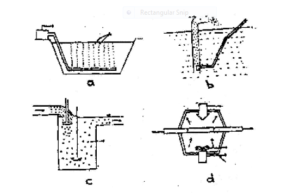
a) Diffused type b) Air lift type c) U-tube type d) Splasher type
Rol e O F F l lter s l N e e wat e R qua ik het ja m een zeuren e Heren t
Aquatic culture systems contain living organisms in water.These organisms require inputs, such as food and they excrete other materials. The inputs must be mixed with or dissolved in water to be available to the organisms, whose outputs will also become mixed with or dissolved in water. Excessive output and/or input can become toxic if the concentration is allowed to increase in the culture water. The process of removing excess materials is called filtration. It consists of passing the water through a thick layer of sand and gravel which act as strainers. Suspended and colloidal matter in the water and also a large number of bacteria are caught in the interstices of the sand during its passage. The mechanical, biological and airlift filters are generally adopted in aquaculture practices to manage and control the water quality for intensive rearing and culture.
Mechan l ca ik filt e R
A mechanical filter (Fig 5.8 a) is an under drained water tight basin in which the filtering materials are placed. The size of a mechanical slow sand filter unit may be about 30 to 60 m x 15 to 30 m or more and about 2.5 m to 3.5 m deep according to desired flow. Water after passing through the filter is collected in an outlet chamber, which is equipped with a flow regulating arrangement. The filtering material about 90 cm to 150 cm of which about 60 cm to 90 cm is fine sand, is laid on top of the under drainage system in five or six layers in progressively smaller sizes towards the top.
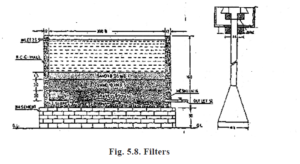
a) Mechanical filter b) Airlift filter.
The sand is supported on two or three layers of graded gravel, with the finest layer immediately below the sand and the coarsest material at the bottom of the filter, packed around the drains. The gravel layers must be graded sufficient to prevent the material from mixing and the sand being drawn down.
The following thickness may be taken for the filtering materials from the bottom towards the top.
1. 10 cm to 15 cm of broken stone 40 mm to 65 mm size
2. 8 cm to 15 cm of gravel 20 mm to 40 mm size
3. 5 cm to 10 cm of gravel 3 mm to 6 mm size
4. 15 cm of coarse sand and
5. 60 cm to 90 cm of fairly uniform fine sand.
When the resistance in the filter (due to sand and clogging) i.e., loss of head, is equal to the total depth of water on the filter, the operation will stop. The loss of head should not be greater than the depth of the filtering sand. When it becomes excessive and before a negative head is formed the filter should be cleaned. The level of the filtered water at the outlet chamber should not be below the level of the surface of the filter sand.
The rate of filtration is 120 litre per minute when the graded layers are 1′ sand of 0.05 to 0.1 mm, 6″ sand of 0.1 to 0.5 mm, 6″ gravel 2 to 5 mm and 1′ metal 5 to 10 mm at the total filtering surface area of 144 square feet.
Biologica ik filte R
It comprises the mineralisation of organic nitrogenous compounds, nitrification and dentrification by bacteria suspended in the water and attached to the gravel in the filter bed.
Heterotrophic and autotrophic bacteria are the major groups present in culture systems. Heterotrophic species utilize organic nitrogenous compounds excreted by the animals as energy sources and convert them into simple compounds, such as ammonia. The mineralisation of these organics is the first stage in biological filtration. It is accomplished in two steps; ammonification, which is the chemical breakdown of proteins and nucleic acids producing amino acids, and organic nitrogenous base and deamination in which a portion of organics and some of the products of ammonification are converted to inorganic compounds.
Once organics have been mineralised by heterotrophs, biological filtration shifts to the second stage which is nitrification, it is the biological oxidation of ammonia to nitrite and then to nitrate by autotrophic bacteria. Those organisms unlike heterotrophs require an inorganic substrate as energy source and utilise carbondioxide as their only source of carbon. Nitrosomonas en Nitrobacter sp. are the principal nitrifying bacteria in culture systems. Nitrosomonas oxidises ammonia to nitrite, Nitrobacter oxidises nitrite to nitrate.
The third and last stage in biological filtration is dentrification. This process is a biological reduction of nitrate to nitrite to either nitrous oxide or free nitrogen. Dentrification can apparently be carried out by both heterotrophic and autotrophic bacteria.
EEN l R ik indien t filt e R
It is the most trouble free means of filtering water through synthetic sponge layer by pumping the water with air lift (fig 5.8b). In culture applications, lift pipe extends below water level and the filter chamber rests above the top water surface. The suspended or colloidal impurities upto the size of 0.002 mm can be filtered out through this system. By pumping 5 cm3 air /sec/. 2 litres of water per minute can be filtered when the diameter of the lift pipe is 1 cm.
S uhm m ar ja
Fish culture is practised in ponds. These are small shallow bodies of water in natural conditions and completely drainable, usually constructed artificially.The natural ponds differ from the lakes in having a relatively large littoral zone and a small profundal zone. Their source of water may also vary.
Nursery ponds are also called transplantation ponds. These are seasonal ponds and are constructed near the spawning and rearing ponds. The main object is to create a suitable condition of food availability and growth of fry because at this stage they are most susceptible to hazards like the wave action and predators. These should be small and shallow ponds 0.02-0.06 ha. in size and 1-1.5 m. in depth. In the nurseries, the spawn (5-6 mm) are reared to fry stage (25-30 mm) for about 15 days. These ponds are usually rectangular in size. Extra care should taken for rearing the young stages, otherwise heavy mortality may occur. Sometimes the spawn are cultured for 30 days also. The pond bottom should gently slope towards the outlet to facilitate easy netting operations. Small and seasonal nurseries are preferred as they help in effective control of the environmental conditions. In practice about 10 million spawn per hectare are stocked in nursery ponds.
Rearing ponds should be slightly larger but not proportionally deep. These should be located near the nursery pond and their number may vary depending upon culture. They should preferably be 0.08-0.10 ha in size and 1.5-2.0 m in depth. The fry (25-30 mm) are reared here upto the fingerling (100-150 mm) stage for about 3-4 months. Carp fry grown in nursery ponds are relatively small in size and not fit enough for their direct transfer into stocking ponds. In stocking ponds bigger fishes are likely to be present which may prey upon the fry. Vandaar, it is desirable to grow the fry in rearing ponds under proper management practices upto fingerling size so that their ability to resist predation will be improved.
Stocking ponds are the largest ponds and are more deep, with a depth of about 2-2.5 m. The size of the pond may vary from 0.2-2.0 ha., but these should preferably be 0.4-0.5 ha in size. These are rectangular in shape. The fingerlings and advance fingerlings are reared upto marketable size for about 6 months. One year old fishes may grow upto 1 kg. or more in weight.
The pond management consists of pre-stocking, stocking and post stocking management phases.
Pre-stocking pond management involves site selection, eradication of weeds, insects and predators, liming, manuring, enzovoort.
Post-stocking pond management involves water quality management, feed and health management and harvesting.
Based on the intensity of infestation and type of weeds, the aquatic weeds can be controlled by means of manual, chemical and biological methods.
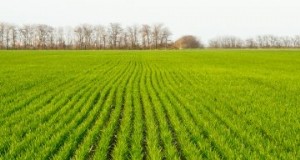
Kleinkorrelig kuilvoer voegt opties toe
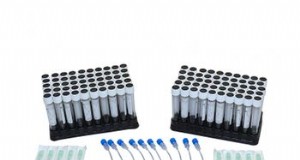
Rhizon - Model 19.21.SA - Bodemvochtmonsterset
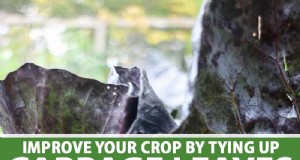
Moet je koolkoppen vastbinden?
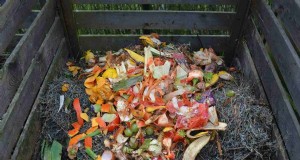
Bokashi-compostering voor huistuin
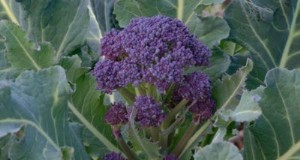
Purple Broccoli Plants – Paarse kiemende broccolizaden planten
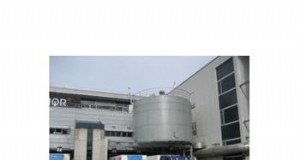
Houtsnippersilo met transportsysteem
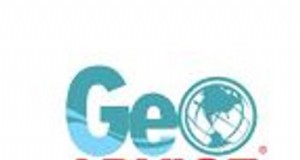
GeoAdvice Pijpbaard
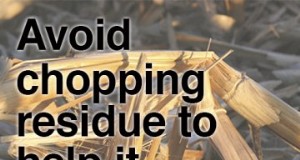
Insider-tip voor machines:heroverweeg het hakselresidu
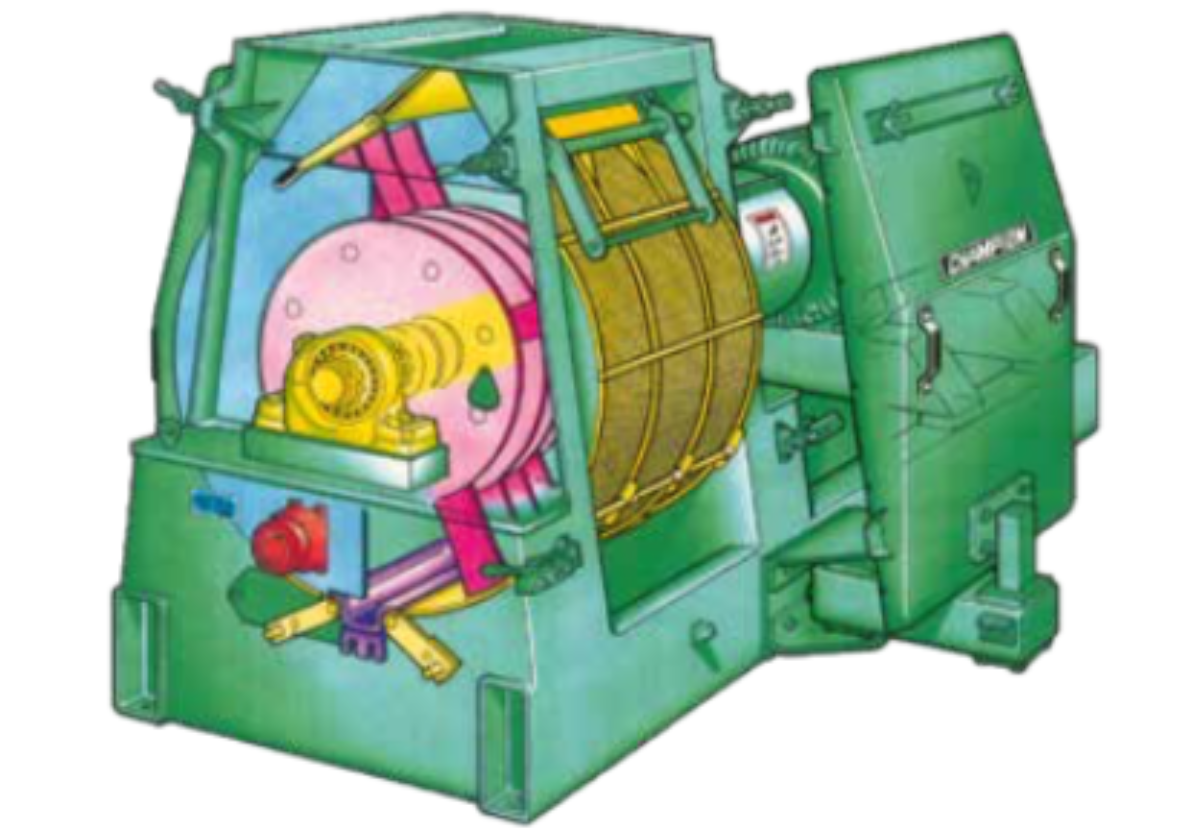
Vermalen van grondstoffen voor aquafeeds
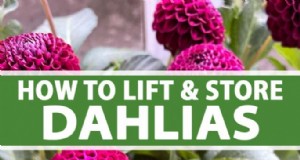
Dahlia's optillen voor winterstalling